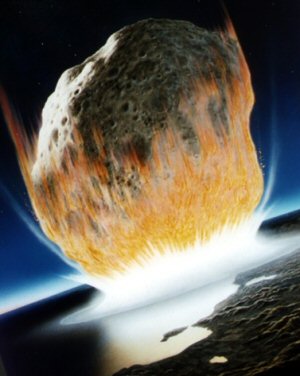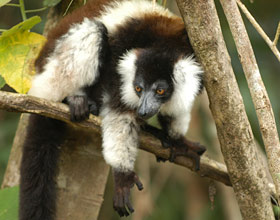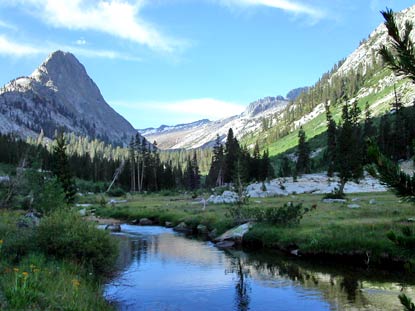Scientists called it the
Permian–Triassic extinction or third extinction, and others called it the Great Dying. This remarkable event, dubbed 'The
Mother of Mass Extinctions,' is by far the most severe in the history of life on earth. It occurred roughly 250 million years ago when, somehow, most of the life on Earth perished in a brief moment of geologic time. During that time, nearly all signs of life were annihilated: trees, plants, lizards, proto-mammals, insects, fish, mollusks, and microbes. An estimated 95 percent of marine species and 70 percent of land species disappeared. Life on our planet almost came to an end. Scientists blame it on severe volcanism, a nearby supernova, environmental changes caused by the formation of a super-continent, the devastating impact of a large asteroid, or a combination of these.

The next wave of extinction was the
Cretaceous–Tertiary extinction, or K-T extinction as it is most widely known, which occurred 65 million years ago. This period ended the reign of dinosaurs and approximately
85 percent of all species. Paleontologists attribute the extinction to meteorite impact or volcanic eruption, or both.

By
sampling animal populations, scientists suggest that we may have entered the sixth wave of extinction, called the
Pleistocene-Holocene extinction.
And this time, the cause isn't an errant asteroid or mega-volcanoes. It's us.
Through the increasing human population, our thirst for natural resources and, most of all, climate change — which could possibly help exterminate 20 to 30 percent of all species before the end of the century — we're shaping an Earth that will be biologically impoverished. A 2008 assessment by the
International Union for Conservation of Nature found that nearly 1 in 4 mammals worldwide was at risk for extinction, including endangered species such the famous Tasmanian devil (the Looney Tunes character
Taz). Overfishing and acidification of the oceans are threatening the diversity of marine species.
Activities such as deforestation, human encroachment, illegal wildlife trade and poaching have caused wildlife species to dwindle significantly.
Brazil is home to
one-third of the world’s remaining rainforests, including a majority of the Amazon rainforest. Tropical forests are home to the greatest concentration of biodiversity on the planet, making Brazil the most biodiverse country in the world with more than 56,000 species of plants, 1,700 species of birds, 695 amphibians, 578 mammals, and 651 reptiles. From 1990 to 2005, the world lost 172 million acres of forest- much of it in South American countries like Brazil, where deforestation has accelerated as land is cleared for
pastures,
infrastructure improvements,
commercial agriculture, and
logging. About 15 percent of the Amazon’s total area has been cleared sine 1970, excluding areas degraded by fires and selective logging.
The jaguar is one of the animals at risk in Brazil. It is considered
near threatened by the
International Union for Conservation of Nature and Natural Resources.
Jaguars function as top predators, regulating the populations of their prey and of smaller predators. This fact makes them important to the health of their native ecosystems.

There are 6.7 billion people in the planet. This number is expected to balloon to 9 billion by 2050. Humans are crowding out other species by sheer number. As consumer demands rise in countries such as India, there could leave little room for wildlife. Sustained growth in India is expected to lead to a major transformation over the next 20 years. As a result, there would be reduced poverty and the formation of a half a billion strong middle class would emerge. This would increase India’s consumption by
four folds, making it the fifth largest consumer market in the world by 2025. So many people cannot help but leave a broad and deep footprint on the landscape. These people would want new and better homes. Land would have to be cleared to make room for those homes, leaving less and less space for wildlife.
India is home to critically endangered endemic species such as the
pygmy hog and Salim Ali’s fruit bat. More than
half of the Indian tiger population has vanished over the past five years. Wildlife activists say that it is due to poaching and urbanization.

The buying and selling of endangered wild animals (as pets, performers and more) is a new and growing menace to wildlife. Total wildlife trade is believed to be the second largest direct threat to many species, after habitat loss. This has become so severe that conservationists have coined the term
empty-forest syndrome to describe habitats that remain in tact but have been stripped of the animals that had once lived there. Southeast Asian countries such as Bangkok and Guangzhou have long been hubs of illegal wildlife trade. The live markets there sell anything from live primates and turtles to tiger claws and various body parts.
In 2008, the
Royal Thai Police seized birds, tortoises and marine products during a raid a Chatuchak market in Bangkok, the country’s largest wildlife market. The seized tortoises included Radiated and Ploughshare tortoises endemic to Madagascar, Ploughshare being one of the world’s most rare tortoise species. Such species are banned from international trade, but somehow increasing numbers are seen for sale in pet markets in Thailand, Indonesia and Malaysia.

From the illegal slaughter of elephants for their ivory to the hunting of apes and gorillas for food, poaching remains a serious threat to some of the world’s most charismatic species. The rising global trade in animal parts, such as tiger penises, have made killing even more profitable. In the Congo Basin in Central Africa, three-fifths of all large mammals are being hunted at unsustainable rates. Commercial bushmeat hunters use more efficient killing machines such as shotguns and snares rather than traditional spears and nets, to bring lucrative
bushmeat to growing markets in African villages and cities.
The loss of wildlife threatens the livelihoods and food security of
indigenous and rural populations that depend on wildlife as a staple or supplement to their diet. In the Congo Basin alone, more than one million metric tons of bush meat- an amount equal to four million cattle- are harvested from the shrinking forests every year, more than six times the maximum sustainable rate, according to the Wildlife Conservation Society's Elizabeth Bennett.

Many species that have lived before are now extinct. Humans have survived and few of us even feel the impact of its disappearance. Evolution demands extinction. So why should the loss of a few species among millions matter to us? Are species such as the Holdrige’s toad, Yangtze River Dolphin and the golden toad- all of which have disappeared within recent years- really that important?
The answer is ‘yes’. Like every other form of life, we are animals dependent on this planet, too. The more diverse the animals in an ecosystem, the healthier and more productive it is- which is good for us. A recent
study by the World Wildlife Fund estimates the economic value of the Amazon rain forest's ecosystem services to be up to $100 per hectare. Moreover, there could be animals and organisms of medicinal value that have yet to be discovered. For example, the herb meadowseed was originally used in aspirin, and the Chinese use porcupine extracts as an effective cure for dengue fever.
Extinction is forever. It cannot be reversed. Forests burned can grow back and polluted air and water can be cleaned- but extinction is permanent. It is not just a few species that are at risk of extinction- we are talking about hundreds of thousands to millions of species that could possibly disappear. Many of these species have not even been discovered yet. We could doom ourselves to what naturalist E.O. Wilson calls the
Eremozoic Era — the Age of Loneliness.
Environmental groups around the world are coming up with new ways to protect threatened wildlife. For example, in conservation hot spots like Madagascar and Brazil, conservationists are working with locals to ensure that the protection of endangered species are linked with the welfare of people who live close to them. Conservationists also hope to create protected corridors to provide roaming room for animals that are forced to migrate to escape changing climates.
Avoided deforestation provides an incentive for environmental protection by putting a value on the carbon that is contained in the trees of a forest. Countries can then trade in these carbon credits, provided that those trees are not cut or burned. This could potentially mean
billions of dollars for developing countries. In 1997, the American nonprofit the Nature Conservancy, American utility companies such as American Electric Power and PacifiCorp, and oil major BP Amoco paid Bolivia $10.8 million for the credits represented by all the carbon in the
Noel Kempff Mercado National Park. It is uncertain that these efforts will prevent the sixth wave of extinction, but it's worth a try.
In a world where billions of people are starving and where the global economic crisis has people struggling to make ends meet, it's easy not to be concerned about Earth's diminishing biodiversity. But this planet is all we have. All that sustains wildlife- the clean water, unblemished land and lush forests- ultimately sustains us as well. As Al Gore said in his Nobel prize acceptance
speech in October 2007, "We face a true planetary emergency. The climate crisis is not a political issue, it is a moral and spiritual challenge to all of humanity. It is also our greatest opportunity to lift global consciousness to a higher level." We were the cause of the animals' plights, but we are also the solution.





























